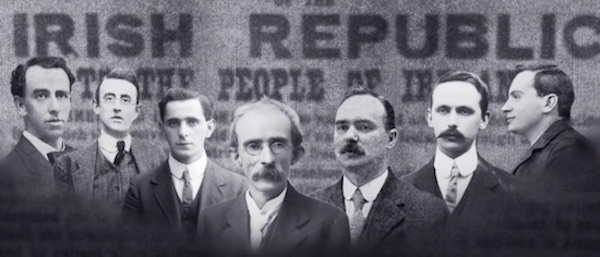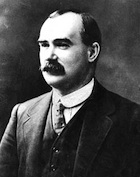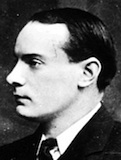
Short biographies of the seven rebels who signed Ireland’s historic declaration of independence in 1916. The first in a two-part series.

JAMES CONNOLLY (1868-1916)
Born in Edinburgh to Irish immigrant parents, Connolly was one of the seven signatories of the Proclamation and one of three to sign the surrender. Raised in poverty, his interest in Irish nationalism is said to have stemmed from a Fenian uncle, while his socialist spark came from an impoverished working-class childhood combined with his readings of Karl Marx and others.
Connolly first came to Ireland as a member of the British Army. Age 14, he forged documents to enlist to escape poverty and was posted to Cork, Dublin and later the Curragh in Kildare.
In Dublin he met Lillie Reynolds and they married in 1890. Despite returning to Scotland, the Irish diaspora in Edinburgh stimulated Connolly’s growing interest in Irish politics in the mid 1890s, leading to his emigration to Dublin in 1896. Here, he founded the Irish Socialist Republican Party.
Connolly spent much of the first decade of the 20th century in America, returning to Ireland to campaign for worker’s rights with James Larkin.
Co-founder of the Labour Party in 1912, Connolly would unite Catholic and Protestant colleagues against employers as the Irish Transport and General Workers’ Union battled for workers’ rights -- strikes which were countered by the employers in the notorious Dublin Lock-out of 1913.
Connolly was instrumental in establishing the Citizen Army in 1913 and publicly criticised the Irish Volunteers for inactivity. He opposed conscription, and flew the banner, ‘We serve neither King nor Kaiser, but Ireland’ at Liberty Hall.
On Easter Monday he led his Citizen Army alongside the Volunteers under Pearse and the wording of the Proclamation is said to be heavily influenced by Connolly’s rhetoric.
He served as Commandant-General Dublin Division in the GPO and was badly wounded before the evacuation to Moore Street.
James Connolly was executed by a firing squad in Kilmainham Gaol at dawn on May 12, 1916 while strapped to a chair. His final resting place is at Arbour Hill cemetery, Dublin.
In Dublin there is a statue of Connolly outside Liberty Hall and others in New York and Chicago, a measure of his international influence.
Connolly Station, one of the main railway stations in Dublin and a hospital in Blanchardstown are also named in his honour.

THOMAS J. CLARKE (1858-1916)
Born on the Isle of Wight to Irish parents, Clarke’s father was a sergeant in the British army who was stationed there. The family moved to South Africa and later to Dungannon, Co Tyrone, where Clarke grew up from about the age of seven, attending Saint Patrick’s national school.
In 1882, he emigrated to American. During his time there he joined the republican organisation Clan na Gael and, as a proponent of violent revolution, he would serve 15 years in British jails for his role in a bombing campaign in London.
Clarke was released in 1898, and spent nine more years in America. He returned to Dublin in 1907 setting up a tobacconist’s shop on Great Britain Street (now Parnell Square), before being co-opted onto the IRB Military Council which was responsible for planning the Easter Rising.
Because of his criminal convictions, Clarke maintained a low profile in Ireland, but was influential behind the scenes in the years of preparation for the Rising. With Denis McCullough, Bulmer Hobson and Sean Mac Diarmada, Clarke revitalised the IRB and had a major role in setting up the Irish Freedom newspaper.
Devoted to the formation of an Irish republic, Clarke was also Chairman and a Trustee of the Wolfe Tone Memorial Committee, which organised the first pilgrimage to his grave at Bodenstown, Co Kildare in 1911.
The first signatory of the Proclamation of Independence because of his seniority and commitment to the cause of Irish independence, Clarke was with the group that occupied the GPO. He opposed the surrender, but was outvoted.
He was married to Kathleen Daly, niece of the veteran Fenian John Daly, and had three children.
In 1922, a collection of his prison writings, Glimpses of an Irish Felon’s Prison Life, was published.
Clarke wrote: “Clinch your teeth hard and never say die. Keep your thoughts off yourself all you can.”
He faced the firing squad at Kilmainham Gaol on May 3, 1916, age 59.
Before its demolition in 2008, a tower in Ballymun, Dublin, and a railway station in Dundalk, Co Louth, were named after Clarke.

PADRAIG PEARSE (1879-1916)
Born in Dublin on Great Brunswick Street (now Pearse Street), he was educated by the Christian Brothers at Westland Row, before taking a scholarship to the Royal University (University College Dublin) to study law.
In 1898 Pearse became a member of the Executive Committee of the Gaelic League. He graduated from the Royal University in 1901 with a degree in Arts and Law. He was later called to the bar. From his early school days he was deeply interested in Irish language and culture. He joined the Gaelic League in 1895 and became editor of its paper, An Claidheamh Soluis (Sword of light). He lectured in Irish at UCD.
To advance his ideal of a free and Gaelic Ireland Pearse set up a bilingual school for boys, St Enda’s, at Cullenswood House, Ranelagh, Dublin, in September 1908. He later moved the school to a larger location at Rathfarnham in 1910.
Initially, Pearse was a supporter of Home Rule but his outlook on Irish freedom was to become more radical and when the Irish Volunteers formed in November 1913, he was elected a member of the provisional committee and later the Director of Organisation.
In July 1914, Pearse was involved in the smuggling of weapons and ammunition through Howth Co Dublin which were stored at St Enda’s.
As his views became more militant, Pearse’s graveside oration at the funeral of Fenian leader O’Donovan Rossa in 1915 ended with the much quoted words “Ireland unfree shall never be at peace”.
One of the founder members of the Irish Volunteers, and the author of the Proclamation of Independence, Pearse was present in the GPO during the Rising, and was Commander in Chief of the Irish forces.
At 3.30pm on April 29, 1916 he surrendered unconditionally on behalf of the Volunteers to Brigadier-General W. H. M. Lowe in Parnell Street, to prevent further loss of civilian life.
Following a court martial at Richmond Barracks for his part in the Easter Rising, Pearse exclaimed: “You cannot conquer Ireland. You cannot extinguish the Irish passion of freedom. If our deed has not been sufficient to win freedom, then our children will win it by a better deed.”
He was executed holding a crucifix on May 3, 1916 at Kilmainham, and was buried in quick lime at Arbour Hill. He was unmarried. Pearse’s brother William was also executed.
In Ballymun, the Patrick Pearse Tower was named after him as was Pearse Street, Dublin.
![[Irish Republican News]](https://republican-news.org/graphics/title_gifs/rn.gif)
![[Irish Republican News]](https://republican-news.org/graphics/title_gifs/harp.gif)

